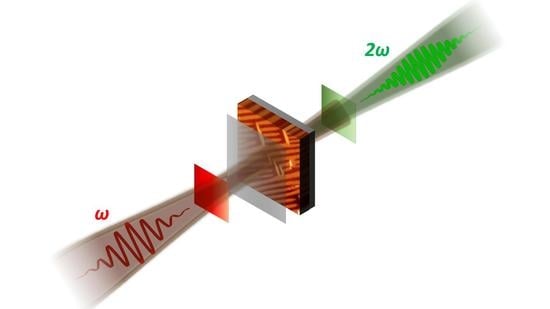Probing Ferroic States in Oxide Thin Films Using Optical Second Harmonic Generation
Abstract
1. Introduction
1.1. Ferroelectric Thin Films
1.2. Multiferroicity in Thin Films
1.3. Ferroic Domain Engineering in Single Layers and Superlattices
1.4. Current Challenges in Probing Ferroic Domains in Thin Films
2. Optical Second Harmonic Generation for Investigation of Ferroic Materials
2.1. SHG in Bulk Ferroic Systems
2.2. Special Considerations in Thin Film SHG Experiments
3. Probing Ferroic States in Thin Films Using SHG
3.1. Optical Second Harmonic in Domain Engineered Ferroic Thin Films
3.2. Imaging of Ferroic Switching Events
3.3. Domain Wall Architecture
4. Future Perspectives
4.1. Remaining Challenges in 3D Resolution in Thin Films
4.2. Probing Ferroelectric Heterostructures during the Growth Process
4.3. Towards Magnetoelectric Switching Dynamics
5. Conclusions
Acknowledgments
Conflicts of Interest
References
- Scott, J.F.; De Araujo, C.A.P. Ferroelectric memories. Science 1989, 246, 1400–1405. [Google Scholar] [CrossRef] [PubMed]
- Setter, N.; Damjanovic, D.; Eng, L.; Fox, G.; Gevorgian, S.; Hong, S.; Kingon, A.; Kohlstedt, H.; Park, N.Y.; Stephenson, G.B.; et al. Ferroelectric thin films: Review of materials, properties, and applications. J. Appl. Phys. 2006, 100, 051606. [Google Scholar] [CrossRef]
- Garcia, V.; Bibes, M.; Bocher, L.; Valencia, S.; Kronast, F.; Crassous, A.; Moya, X.; Enouz-Vedrenne, S.; Gloter, A.; Imhoff, D.; et al. Ferroelectric Control of Spin Polarization. Science 2010, 327, 1106–1110. [Google Scholar] [CrossRef] [PubMed]
- Chanthbouala, A.; Garcia, V.; Cherifi, R.O.; Bouzehouane, K.; Fusil, S.; Moya, X.; Xavier, S.; Yamada, H.; Deranlot, C.; Mathur, N.D.; et al. A ferroelectric memristor. Nat. Mater. 2012, 11, 860–864. [Google Scholar] [CrossRef]
- Junquera, J.; Ghosez, P. Critical thickness for ferroelectricity in perovskite ultrathin films. Nature 2003, 422, 506–509. [Google Scholar] [CrossRef] [PubMed]
- Fong, D.D.; Stephenson, G.B.; Streiffer, S.K.; Eastman, J.A.; Auciello, O.; Fuoss, P.H.; Thompson, C. Ferroelectricity in ultrathin perovskite films. Science 2004, 304, 1650–1653. [Google Scholar] [CrossRef] [PubMed]
- Schlom, D.G.; Chen, L.Q.; Eom, C.B.; Rabe, K.M.; Streiffer, S.K.; Triscone, J.M. Strain tuning of ferroelectric thin films. Annu. Rev. Mater. Res. 2007, 37, 589–626. [Google Scholar] [CrossRef]
- Damodaran, A.R.; Agar, J.C.; Pandya, S.; Chen, Z.; Dedon, L.; Xu, R.; Apgar, B.; Saremi, S.; Martin, L.W. New modalities of strain-control of ferroelectric thin films. J. Phys. Condens. Matter 2016, 28, 263001. [Google Scholar] [CrossRef] [PubMed]
- Scott, J.F. Multiferroic memories. Nat. Mater. 2007, 6, 256–257. [Google Scholar] [CrossRef] [PubMed]
- Gajek, M.; Bibes, M.; Fusil, S.; Bouzehouane, K.; Fontcuberta, J.; Barthélémy, A.; Fert, A. Tunnel junctions with multiferroic barriers. Nat. Mater. 2007, 6, 296–302. [Google Scholar] [CrossRef] [PubMed]
- Trassin, M. Low energy consumption spintronics using multiferroic heterostructures. J. Phys. Condens. Matter 2016, 28, 033001. [Google Scholar] [CrossRef] [PubMed]
- Heron, J.T.; Trassin, M.; Ashraf, K.; Gajek, M.; He, Q.; Yang, S.Y.; Nikonov, D.E.; Chu, Y.H.; Salahuddin, S.; Ramesh, R. Electric-Field-Induced Magnetization Reversal in a Ferromagnet-Multiferroic Heterostructure. Phys. Rev. Lett. 2011, 107, 217202. [Google Scholar] [CrossRef] [PubMed]
- Heron, J.T.; Bosse, J.L.; He, Q.; Gao, Y.; Trassin, M.; Ye, L.; Clarkson, J.D.; Wang, C.; Liu, J.; Salahuddin, S.; et al. Deterministic switching of ferromagnetism at room temperature using an electric field. Nature 2014, 516, 370–373. [Google Scholar] [CrossRef] [PubMed]
- Heron, J.T.; Schlom, D.G.; Ramesh, R. Electric field control of magnetism using BiFeO3-based heterostructures. Appl. Phys. Rev. 2014, 1, 021303. [Google Scholar] [CrossRef]
- Bibes, M.; Barthélémy, A. Multiferroics: Towards a magnetoelectric memory. Nat. Mater. 2008, 7, 425–426. [Google Scholar] [CrossRef] [PubMed]
- Denev, S.A.; Lummen, T.T.A.; Barnes, E.; Kumar, A.; Gopalan, V. Probing Ferroelectrics Using Optical Second Harmonic Generation. J. Am. Ceram. Soc. 2011, 94, 2699–2727. [Google Scholar] [CrossRef]
- Fiebig, M.; Pavlov, V.V.; Pisarev, R.V. Second-harmonic generation as a tool for studying electronic and magnetic structures of crystals: Review. J. Opt. Soc. Am. B 2005, 22, 96–118. [Google Scholar] [CrossRef]
- Yokota, H.; Kaneshiro, J.; Uesu, Y. Optical Second Harmonic Generation Microscopy as a Tool of Material Diagnosis. Phys. Res. Int. 2012, 2012, 704634. [Google Scholar] [CrossRef]
- Khestanova, E.; Dix, N.; Fina, I.; Scigaj, M.; Rebled, J.M.; Magén, C.; Estradé, S.; Peiró, F.; Herranz, G.; Fontcuberta, J.; et al. Untangling electrostatic and strain effects on the polarization of ferroelectric superlattices. Adv. Funct. Mater. 2016, 26, 6446–6453. [Google Scholar] [CrossRef]
- Liu, G.; Chen, J.; Lichtensteiger, C.; Triscone, J.M.; Aguado-Puente, P.; Junquera, J.; Valanoor, N. Positive Effect of an Internal Depolarization Field in Ultrathin Epitaxial Ferroelectric Films. Adv. Electron. Mater. 2016, 2, 1500288. [Google Scholar] [CrossRef]
- Bein, B.; Hsing, H.C.; Callori, S.J.; Sinsheimer, J.; Chinta, P.V.; Headrick, R.L.; Dawber, M. In situ X-ray diffraction and the evolution of polarization during the growth of ferroelectric superlattices. Nat. Commun. 2015, 6, 10136. [Google Scholar] [CrossRef] [PubMed]
- Zubko, P.; Gariglio, S.; Gabay, M.; Ghosez, P.; Triscone, J.M. Interface Physics in Complex Oxide Heterostructures. Annu. Rev. Condens. Matter Phys. 2011, 2, 141–165. [Google Scholar] [CrossRef]
- Stephenson, G.B.; Highland, M.J. Equilibrium and stability of polarization in ultrathin ferroelectric films with ionic surface compensation. Phys. Rev. B 2011, 84, 064107. [Google Scholar] [CrossRef]
- Lichtensteiger, C.; Dawber, M.; Stucki, N.; Triscone, J.M.; Hoffman, J.; Yau, J.B.; Ahn, C.H.; Despont, L.; Aebi, P. Monodomain to polydomain transition in ferroelectric PbTiO3 thin films with La0.67Sr0.33MnO3 electrodes. Appl. Phys. Lett. 2007, 90, 052907. [Google Scholar] [CrossRef]
- Dawber, M.; Chandra, P.; Littlewood, P.B.; Scott, J.F. Depolarization corrections to the coercive field in thin-film ferroelectrics. J. Phys. Condens. Matter 2003, 15, L393–L398. [Google Scholar] [CrossRef]
- Streiffer, S.K.; Eastman, J.A.; Fong, D.D.; Thompson, C.; Munkholm, A.; Ramana Murty, M.V.; Auciello, O.; Bai, G.R.; Stephenson, G.B. Observation of nanoscale 180 degrees stripe domains in ferroelectric PbTiO3 thin films. Phys. Rev. Lett. 2002, 89, 067601. [Google Scholar] [CrossRef] [PubMed]
- Tenne, D.A.; Bruchhausen, A.; Lanzillotti-Kimura, N.D.; Fainstein, A.; Katiyar, R.S.; Cantarero, A.; Soukiassian, A.; Vaithyanathan, V.; Haeni, J.H.; Tian, W.; et al. Probing nanoscale ferroelectricity by ultraviolet Raman spectroscopy. Science 2006, 313, 1614–1616. [Google Scholar] [CrossRef] [PubMed]
- Dawber, M.; Stucki, N.; Lichtensteiger, C.; Gariglio, S.; Ghosez, P.; Triscone, J.M. Tailoring the properties of artificially layered ferroelectric superlattices. Adv. Mater. 2007, 19, 4153–4159. [Google Scholar] [CrossRef]
- Lee, H.N.; Christen, H.M.; Chisholm, M.F.; Rouleau, C.M.; Lowndes, D.H. Strong polarization enhancement in asymmetric three-component ferroelectric superlattices. Nature 2005, 433, 395–399. [Google Scholar] [CrossRef] [PubMed]
- Scott, J.F. Ferroelectrics go bananas. J. Phys. Condens. Matter 2008, 20, 021001. [Google Scholar] [CrossRef]
- Rijnders, G.J.H.M.; Koster, G.; Blank, D.H.A.; Rogalla, H. In situ monitoring during pulsed laser deposition of complex oxides using reflection high energy electron diffraction under high oxygen pressure. Appl. Phys. Lett. 1997, 70, 1888–1890. [Google Scholar] [CrossRef]
- Ederer, C.; Spaldin, N.A. Effect of Epitaxial Strain on the Spontaneous Polarization of Thin Film Ferroelectrics. Phys. Rev. Lett. 2005, 95, 257601. [Google Scholar] [CrossRef] [PubMed]
- Choi, K.J.; Biegalski, M.; Li, Y.L.; Sharan, A.; Schubert, J.; Uecker, R.; Reiche, P.; Chen, Y.B.; Pan, X.Q.; Gopalan, V.; et al. Enhancement of Ferroelectricity in Strained BaTiO3 Thin Films. Science 2004, 5, 1005–1009. [Google Scholar] [CrossRef] [PubMed]
- Damodaran, A.R.; Breckenfeld, E.; Chen, Z.; Lee, S.; Martin, L.W. Enhancement of ferroelectric Curie temperature in BaTiO3 films via straininduced defect dipole alignment. Adv. Mater. 2014, 26, 6341–6347. [Google Scholar] [CrossRef] [PubMed]
- Xu, R.; Liu, S.; Grinberg, I.; Karthik, J.; Damodaran, A.R.; Rappe, A.M.; Martin, L.W. Ferroelectric polarization reversal via successive ferroelastic transitions. Nat. Mater. 2015, 14, 79–86. [Google Scholar] [CrossRef] [PubMed]
- White, J.S.; Bator, M.; Hu, Y.; Luetkens, H.; Stahn, J.; Capelli, S.; Das, S.; Döbeli, M.; Lippert, T.; Malik, V.K.; et al. Strain-Induced Ferromagnetism in Antiferromagnetic LuMnO3 Thin Films. Phys. Rev. Lett. 2013, 111, 037201. [Google Scholar] [CrossRef] [PubMed]
- Becher, C.; Maurel, L.; Aschauer, U.; Lilienblum, M.; Magén, C.; Meier, D.; Langenberg, E.; Trassin, M.; Blasco, J.; Krug, I.P.; et al. Strain-induced coupling of electrical polarization and structural defects in SrMnO3 films. Nat. Nanotechnol. 2015, 10, 661–665. [Google Scholar] [CrossRef] [PubMed]
- Fiebig, M.; Lottermoser, T.; Meier, D.; Trassin, M. The evolution of multiferroics. Nat. Rev. Mater. 2016, 1, 16046. [Google Scholar] [CrossRef]
- Fiebig, M. Revival of the magnetoelectric effect. J. Phys. D Appl. Phys. 2005, 38, R123–R152. [Google Scholar] [CrossRef]
- Spaldin, N.A.; Fiebig, M. The Renaissance of Magnetoelectric Multiferroics. Science 2005, 309, 391–392. [Google Scholar] [CrossRef] [PubMed]
- Wang, J.; Neaton, J.B.; Zheng, H.; Nagarajan, V.; Ogale, S.B.; Liu, B.; Viehland, D.; Vaithyanathan, V.; Schlom, D.G.; Waghmare, U.V.; et al. Epitaxial BiFeO3 Multiferroic Thin Film Heterostructures. Science 2003, 299, 1719–1722. [Google Scholar] [CrossRef] [PubMed]
- Martí, X.; Sánchez, F.; Hrabovsky, D.; Fàbrega, L.; Ruyter, A.; Fontcuberta, J.; Laukhin, V.; Skumryev, V.; García-Cuenca, M.V.; Ferrater, C.; et al. Exchange biasing and electric polarization with YMnO3. Appl. Phys. Lett. 2006, 89, 032510. [Google Scholar] [CrossRef]
- Laukhin, V.; Skumryev, V.; Martí, X.; Hrabovsky, D.; Sánchez, F.; García-Cuenca, M.V.; Ferrater, C.; Varela, M.; Lüders, U.; Bobo, J.F.; et al. Electric-Field Control of Exchange Bias in Multiferroic Epitaxial Heterostructures. Phys. Rev. Lett. 2006, 97, 227201. [Google Scholar] [CrossRef] [PubMed]
- Ramesh, R.; Spaldin, N.A. Multiferroics: Progress and prospects in thin films. Nat. Mater. 2007, 6, 21–29. [Google Scholar] [CrossRef] [PubMed]
- Shimamoto, K.; Mukherjee, S.; Manz, S.; White, J.S.; Trassin, M.; Kenzelmann, M.; Chapon, L.; Lippert, T.; Fiebig, M.; Schneider, C.W.; et al. Tuning the multiferroic mechanisms of TbMnO3 by epitaxial strain. Sci. Rep. 2017, 7, 44753. [Google Scholar] [CrossRef] [PubMed]
- Trassin, M.; Viart, N.; Versini, G.; Loison, J.L.; Vola, J.P.; Schmerber, G.; Crégut, O.; Barre, S.; Pourroy, G.; Lee, J.H.; et al. Epitaxial thin films of multiferroic GaFeO3 on conducting indium tin oxide (001) buffered yttrium-stabilized zirconia (001) by pulsed laser deposition. Appl. Phys. Lett. 2007, 91, 202504. [Google Scholar] [CrossRef]
- Chu, Y.H.; Martin, L.W.; Holcomb, M.B.; Gajek, M.; Han, S.J.; He, Q.; Balke, N.; Yang, C.H.; Lee, D.; Hu, W.; et al. Electric-field control of local ferromagnetism using a magnetoelectric multiferroic. Nat. Mater. 2008, 7, 478–482. [Google Scholar] [CrossRef] [PubMed]
- Yadav, A.K.; Nelson, C.T.; Hsu, S.L.; Hong, Z.; Clarkson, J.D.; Schlepüetz, C.M.; Damodaran, A.R.; Shafer, P.; Arenholz, E.; Dedon, L.R.; et al. Observation of polar vortices in oxide superlattices. Nature 2016, 530, 198–201. [Google Scholar] [CrossRef] [PubMed]
- Shafer, P.; García-Fernández, P.; Aguado-Puente, P.; Damodaran, A.R.; Yadav, A.K.; Nelson, C.T.; Hsu, S.L.; Wojdel, J.C.; Íñiguez, J.; Martin, L.W.; et al. Emergent chirality in the electric polarization texture of titanate superlattices. Proc. Natl. Acad. Sci. USA 2018, 115, 915–920. [Google Scholar] [CrossRef] [PubMed]
- Khan, A.I.; Chatterjee, K.; Wang, B.; Drapcho, S.; You, L.; Serrao, C.; Bakaul, S.R.; Ramesh, R.; Salahuddin, S. Negative capacitance in a ferroelectric capacitor. Nat. Mater. 2015, 14, 182–186. [Google Scholar] [CrossRef] [PubMed]
- Zubko, P.; Wojdeł, J.C.; Hadjimichael, M.; Fernandez-Pena, S.; Sené, A.; Luk'yanchuk, I.; Triscone, J.M.; Íñiguez, J. Negative capacitance in multi-domain ferroelectric superlattices. Nature 2016, 534, 524–528. [Google Scholar] [CrossRef] [PubMed]
- Chu, Y.H.; Cruz, M.P.; Yang, C.H.; Martin, L.W.; Yang, P.L.; Zhang, J.X.; Lee, K.; Yu, P.; Chen, L.Q.; Ramesh, R. Domain Control in Multiferroic BiFeO3 through Substrate Vicinality. Adv. Mater. 2007, 19, 2662–2666. [Google Scholar] [CrossRef]
- Chu, Y.H.; He, Q.; Yang, C.H.; Yu, P.; Martin, L.W.; Shafer, P.; Ramesh, R. Nanoscale control of domain architectures in BiFeO3 thin films. Nano Lett. 2009, 9, 1726–1730. [Google Scholar] [CrossRef] [PubMed]
- Chen, Z.H.; Damodaran, A.R.; Xu, R.; Lee, S.; Martin, L.W. Effect of “symmetry mismatch” on the domain structure of rhombohedral BiFeO3 thin films. Appl. Phys. Lett. 2014, 104, 182908. [Google Scholar] [CrossRef]
- Haeni, J.H.; Irvin, P.; Chang, W.; Uecker, R.; Reiche, P.; Li, Y.L.; Choudhury, S.; Tian, W.; Hawley, M.E.; Craigo, B.; et al. Room-temperature ferroelectricity in strained SrTiO3. Nature 2004, 430, 758–761. [Google Scholar] [CrossRef] [PubMed]
- Vasudevarao, A.; Kumar, A.; Tian, L.; Haeni, J.H.; Li, Y.L.; Eklund, C.J.; Jia, Q.X.; Uecker, R.; Reiche, P.; Rabe, K.M.; et al. Multiferroic Domain Dynamics in Strained Strontium Titanate. Phys. Rev. Lett. 2006, 97, 257602. [Google Scholar] [CrossRef] [PubMed]
- Fennie, C.J.; Rabe, K.M. Magnetic and Electric Phase Control in Epitaxial EuTiO3 from First Principles. Phys. Rev. Lett. 2006, 97, 267602. [Google Scholar] [CrossRef] [PubMed]
- Lee, J.H.; Fang, L.; Vlahos, E.; Ke, X.; Jung, Y.W.; Kourkoutis, L.F.; Kim, J.W.; Ryan, P.J.; Heeg, T.; Roeckerath, M.; et al. A strong ferroelectric ferromagnet created by means of spin-lattice coupling. Nature 2010, 466, 954–958. [Google Scholar] [CrossRef] [PubMed]
- Highland, M.J.; Fister, T.T.; Fong, D.D.; Fuoss, P.H.; Thompson, C.; Eastman, J.A.; Streiffer, S.K.; Stephenson, G.B. Equilibrium Polarization of Ultrathin PbTiO3 with Surface Compensation Controlled by Oxygen Partial Pressure. Phys. Rev. Lett. 2011, 107, 187602. [Google Scholar] [CrossRef] [PubMed]
- Yu, P.; Luo, W.; Yi, D.; Zhang, J.X.; Rossell, M.D.; Yang, C.H.; You, L.; Singh-Bhalla, G.; Yang, S.Y.; He, Q.; et al. Interface control of bulk ferroelectric polarization. Proc. Natl. Acad. Sci. USA 2012, 109, 9710–9715. [Google Scholar] [CrossRef] [PubMed]
- De Luca, G.; Strkalj, N.; Manz, S.; Bouillet, C.; Fiebig, M.; Trassin, M. Nanoscale design of polarization in ultrathin ferroelectric heterostructures. Nat. Commun. 2017, 8, 1419. [Google Scholar] [CrossRef] [PubMed]
- Chen, D.; Chen, Z.; He, Q.; Clarkson, J.D.; Serrao, C.R.; Yadav, A.K.; Nowakowski, M.E.; Fan, Z.; You, L.; Gao, X.; et al. Interface Engineering of Domain Structures in BiFeO3 Thin Films. Nano Lett. 2017, 17, 486–493. [Google Scholar] [CrossRef] [PubMed]
- Lichtensteiger, C.; Weymann, C.; Fernandez-Pena, S.; Paruch, P.; Triscone, J.M. Built-in voltage in thin ferroelectric PbTiO3 films: The effect of electrostatic boundary conditions. New J. Phys. 2016, 18, 043030. [Google Scholar] [CrossRef]
- Lichtensteiger, C.; Fernandez-Pena, S.; Weymann, C.; Zubko, P.; Triscone, J.M. Tuning of the Depolarization Field and Nanodomain Structure in Ferroelectric Thin Films. Nano Lett. 2014, 14, 4205–4211. [Google Scholar] [CrossRef] [PubMed]
- Tang, Y.L.; Zhu, Y.L.; Ma, X.L.; Borisevich, A.Y.; Morozovska, A.N.; Eliseev, E.A.; Wang, W.Y.; Wang, Y.J.; Xu, Y.B.; Zhang, Z.D.; et al. Observation of a periodic array of flux-closure quadrants in strained ferroelectric PbTiO3 films. Science 2015, 348, 547–551. [Google Scholar] [CrossRef] [PubMed]
- Gruverman, A.; Wu, D.; Scott, J.F. Piezoresponse Force Microscopy Studies of Switching Behavior of Ferroelectric Capacitors on a 100-ns. Phys. Rev. Lett. 2008, 100, 097601. [Google Scholar] [CrossRef] [PubMed]
- Jo, J.Y.; Yang, S.M.; Kim, T.H.; Lee, H.N.; Yoon, J.-G.; Park, S.; Jo, Y.; Jung, M.H.; Noh, T.W. Nonlinear Dynamics of Domain-Wall Propagation in Epitaxial Ferroelectric Thin Films. Phys. Rev. Lett. 2009, 102, 045701. [Google Scholar] [CrossRef] [PubMed]
- Lefevre, C.; Demchenko, A.; Bouillet, C.; Luysberg, M.; Devaux, X.; Roulland, F.; Versini, G.; Barre, S.; Wakabayashi, Y.; Boudet, N.; et al. Nondestructive Method for the Determination of the Electric Polarization Orientation in Thin Films: Illustration on Gallium Ferrite Thin Films. Small Methods 2017, 1, 1700234. [Google Scholar] [CrossRef]
- Lahtinen, T.H.E.; Tuomi, J.E.; van Dijken, S. Pattern Transfer and Electric-Field-Induced Magnetic Domain Formation in Multiferroic Heterostructures. Adv. Mater. 2011, 23, 3187–3191. [Google Scholar] [CrossRef] [PubMed]
- Franke, K.J.A.; López González, D.; Hämäläinen, S.J.; van Dijken, S. Size Dependence of Domain Pattern Transfer in Multiferroic Heterostructures. Phys. Rev. Lett. 2014, 112, 017201. [Google Scholar] [CrossRef] [PubMed]
- Franke, K.J.A.; Van de Wiele, B.; Shirahata, Y.; Hämäläinen, S.J.; Taniyama, T.; van Dijken, S. Reversible Electric-Field-Driven Magnetic Domain-Wall Motion. Phys. Rev. X 2015, 5, 011010. [Google Scholar] [CrossRef]
- Trassin, M.; Clarkson, J.D.; Bowden, S.R.; Liu, J.; Heron, J.T.; Paull, R.J.; Arenholz, E.; Pierce, D.T.; Unguris, J. Interfacial coupling in multiferroic/ferromagnet heterostructures. Phys. Rev. B 2013, 87, 134426. [Google Scholar] [CrossRef]
- Unguris, J.; Bowden, S.R.; Pierce, D.T.; Trassin, M.; Ramesh, R.; Cheong, S.W.; Fackler, S.; Takeuchi, I. Simultaneous imaging of the ferromagnetic and ferroelectric structure in multiferroic heterostructures. APL Mater. 2014, 2, 076109. [Google Scholar] [CrossRef]
- You, L.; Wang, B.; Zou, X.; Lim, Z.S.; Zhou, Y.; Ding, H.; Chen, L.; Wang, J. Origin of the uniaxial magnetic anisotropy in La0.7Sr0.3MnO3 on stripe-domain BiFeO3. Phys. Rev. B 2013, 88, 184426. [Google Scholar] [CrossRef]
- Maze, J.R.; Stanwix, P.L.; Hodges, J.S.; Hong, S.; Taylor, J.M.; Cappellaro, P.; Jiang, L.; Dutt, M.V.G.; Togan, E.; Zibrov, A.S.; et al. Nanoscale magnetic sensing with an individual electronic spin in diamond. Nature 2008, 455, 644–647. [Google Scholar] [CrossRef] [PubMed]
- Balasubramanian, G.; Chan, I.Y.; Kolesov, R.; Al-Hmoud, M.; Tisler, J.; Shin, C.; Kim, C.; Wojcik, A.; Hemmer, P.R.; Krueger, A.; et al. Nanoscale imaging magnetometry with diamond spins under ambient conditions. Nature 2008, 455, 648–651. [Google Scholar] [CrossRef] [PubMed]
- Rondin, L.; Tetienne, J.P.; Hingant, T.; Roch, J.F.; Maletinsky, P.; Jacques, V. Magnetometry with nitrogen-vacancy defects in diamond. Rep. Prog. Phys. 2014, 77, 056503. [Google Scholar] [CrossRef] [PubMed]
- Gross, I.; Akhtar, W.; Garcia, V.; Martínez, L.J.; Chouaieb, S.; Garcia, K.; Carrétéro, C.; Barthélémy, A.; Appel, P.; Maletinsky, P.; et al. Real-space imaging of non-collinear antiferromagnetic order with a single-spin magnetometer. Nature 2017, 549, 252–256. [Google Scholar] [CrossRef] [PubMed]
- Kaneshiro, J.; Uesu, Y.; Fukui, T. Visibility of inverted domain structures using the second harmonic generation microscope: Comparison of interference and non-interference cases. J. Opt. Soc. Am. B 2010, 27, 888–894. [Google Scholar] [CrossRef]
- Lüpke, G. Characterization of semiconductor interfaces by second-harmonic generation. Surf. Sci. Rep. 1999, 35, 75–161. [Google Scholar] [CrossRef]
- Fröhlich, D.; Kiefer, T.; Leute, S.; Lottermoser, T. Nonlinear spectroscopy of antiferromagnetics. Appl. Phys. B 1999, 68, 465–471. [Google Scholar] [CrossRef]
- Rubano, A.; Fiebig, M.; Paparo, D.; Marino, A.; Maccariello, D.; di Uccio, U.S.; Granozio, F.M.; Marrucci, L.; Richter, C.; Paetel, S.; et al. Spectral and spatial distribution of polarization at the LaAlO3/SrTiO3 interface. Phys. Rev. B 2011, 83, 155405. [Google Scholar] [CrossRef]
- Lummen, T.T.A.; Gu, Y.; Wang, J.; Lei, S.; Xue, F.; Kumar, A.; Barnes, A.T.; Barnes, E.; Denev, S.; Belianinov, A.; et al. Thermotropic phase boundaries in classic ferroelectrics. Nat. Commun. 2014, 5, 3172. [Google Scholar] [CrossRef] [PubMed]
- Fiebig, M.; Fröhlich, D.; Sluyterman v. L., G.; Pisarev, R.V. Domain topography of antiferromagnetic Cr2O3 by second-harmonic generation. Appl. Phys. Lett. 1995, 66, 2906–2908. [Google Scholar] [CrossRef]
- Schoenherr, P.; Giraldo, L.M.; Lilienblum, M.; Trassin, M.; Meier, D.; Fiebig, M. Magnetoelectric Force Microscopy on Antiferromagnetic 180° Domains in Cr2O3. Materials 2017, 10, 1051. [Google Scholar] [CrossRef] [PubMed]
- Matsubara, M.; Manz, S.; Mochizuki, M.; Kubacka, T.; Iyama, A.; Aliouane, N.; Kimura, T.; Johnson, S.L.; Meier, D.; Fiebig, M. Magnetoelectric domain control in multiferroic TbMnO3. Science 2015, 348, 1112–1115. [Google Scholar] [CrossRef] [PubMed]
- Manz, S.; Matsubara, M.; Lottermoser, T.; Büchi, J.; Iyama, A.; Kimura, T.; Meier, D.; Fiebig, M. Reversible Optical Switching of Antiferromagnetism in TbMnO3. Nat. Photonics 2016, 10, 653–656. [Google Scholar] [CrossRef]
- Trassin, M.; De Luca, G.; Manz, S.; Fiebig, M. Probing Ferroelectric Domain Engineering in BiFeO3 Thin Films by Second Harmonic Generation. Adv. Mater. 2015, 27, 4871–4876. [Google Scholar] [CrossRef] [PubMed]
- Dick, B.; Gierulski, A.; Marowsky, G.; Reider, G.A. Determination of the nonlinear optical susceptibility χ(2) of surface layers by sum and difference frequency generation in reflection and transmission. Appl. Phys. B 1985, 38, 107–116. [Google Scholar] [CrossRef]
- Guyot-Sionnest, P.; Chen, W.; Shen, Y.R. General considerations on optical second-harmonic generation from surfaces and interfaces. Phys. Rev. B 1986, 33, 8254–8263. [Google Scholar] [CrossRef]
- Nagarajan, V.; Jenkins, I.G.; Alpay, S.P.; Li, H.; Aggarwal, S.; Salamanca-Riba, L.; Roytburd, A.L.; Ramesh, R. Thickness dependence of structural and electrical properties in epitaxial lead zirconate titanate films. J. Appl. Phys. 1999, 86, 595–602. [Google Scholar] [CrossRef]
- Nesterov, O.; Matzen, S.; Magen, C.; Vlooswijk, A.H.G.; Catalan, G.; Noheda, B. Thickness scaling of ferroelastic domains in PbTiO3 films on DyScO3. Appl. Phys. Lett. 2013, 103, 142901. [Google Scholar] [CrossRef]
- Feigl, L.; Yudin, P.; Stolichnov, I.; Sluka, T.; Shapovalov, K.; Mtebwa, M.; Sandu, C.S.; Wei, X.K.; Tagantsev, A.K.; Setter, N. Controlled stripes of ultrafine ferroelectric domains. Nat. Commun. 2014, 5, 4677. [Google Scholar] [CrossRef] [PubMed]
- Su, D.; Meng, Q.; Vaz, C.A.F.; Han, M.G.; Segal, Y.; Walker, F.J.; Sawicki, M.; Broadbridge, C.; Ahn, C.H. Origin of 90° domain wall pinning in Pb(Zr0.2Ti0.8)O3 heteroepitaxial thin films. Appl. Phys. Lett. 2011, 99, 102902. [Google Scholar] [CrossRef]
- Gao, P.; Britson, J.; Jokisaari, J.R.; Nelson, C.T.; Baek, S.H.; Wang, Y.; Eom, C.B.; Chen, L.Q.; Pan, X. Atomic-scale mechanisms of ferroelastic domain-wall-mediated ferroelectric switching. Nat. Commun. 2013, 4, 2791. [Google Scholar] [CrossRef]
- Gao, P.; Britson, J.; Nelson, C.T.; Jokisaari, J.R.; Duan, C.; Trassin, M.; Baek, S.H.; Guo, H.; Li, L.; Wang, Y.; et al. Ferroelastic domain switching dynamics under electrical and mechanical excitations. Nat. Commun. 2014, 5, 3801. [Google Scholar] [CrossRef] [PubMed]
- De Luca, G.; Rossell, M.D.; Schaab, J.; Viart, N.; Fiebig, M.; Trassin, M. Domain wall architecture in tetragonal ferroelectric thin films. Adv. Mater. 2017, 29, 1605145. [Google Scholar] [CrossRef] [PubMed]
- Zeches, R.J.; Rossell, M.D.; Zhang, J.X.; Hatt, A.J.; He, Q.; Yang, C.H.; Kumar, A.; Wang, C.H.; Melville, A.; Adamo, C.; et al. A Strain-Driven Morphotropic Phase Boundary in BiFeO3. Science 2009, 326, 977–980. [Google Scholar] [CrossRef] [PubMed]
- Sando, D.; Barthélémy, A.; Bibes, M. BiFeO3 epitaxial thin films and devices: Past, present and future. J. Phys. Condens. Matter 2014, 26, 47320. [Google Scholar] [CrossRef] [PubMed]
- Beekman, C.; Siemons, W.; Ward, T.Z.; Chi, M.; Howe, J.; Biegalski, M.D.; Balke, N.; Maksymovych, P.; Farrar, A.K.; Romero, J.B.; et al. Phase Transitions, Phase Coexistence, and Piezoelectric Switching Behavior in Highly Strained BiFeO3 Films. Adv. Mater. 2013, 25, 5561–5567. [Google Scholar] [CrossRef] [PubMed]
- Kumar, A.; Denev, S.; Zeches, R.J.; Vlahos, E.; Podraza, N.J.; Melville, A.; Schlom, D.G.; Ramesh, R.; Gopalan, V. Probing mixed tetragonal/rhombohedral-like monoclinic phases in strained bismuth ferrite films by optical second harmonic generation. Appl. Phys. Lett. 2010, 97, 112903. [Google Scholar] [CrossRef]
- Haislmaier, R.C.; Podraza, N.J.; Denev, S.; Melville, A.; Schlom, D.G.; Gopalan, V. Large nonlinear optical coefficients in pseudo-tetragonal BiFeO3 thin films. Appl. Phys. Lett. 2013, 103, 031906. [Google Scholar] [CrossRef]
- Kumar, A.; Rai, R.C.; Podraza, N.J.; Denev, S.; Ramirez, M.; Chu, Y.H.; Martin, L.W.; Ihlefeld, J.; Heeg, T.; Schubert, J.; et al. Linear and nonlinear optical properties of BiFeO3. Appl. Phys. Lett. 2008, 92, 121915. [Google Scholar] [CrossRef]
- Zhang, J.; Ke, X.; Gou, G.; Seidel, J.; Xiang, B.; Yu, P.; Liang, W.I.; Minor, A.M.; Chu, Y.H.; van Tendeloo, G.; et al. A nanoscale shape memory oxide. Nat. Commun. 2013, 4, 2768. [Google Scholar] [CrossRef] [PubMed]
- Seidel, J.; Trassin, M.; Zhang, Y.; Maksymovych, P.; Uhlig, T.; Milde, P.; Köhler, D.; Baddorf, A.P.; Kalinin, S.V.; Eng, L.M.; et al. Electronic Properties of Isosymmetric Phase Boundaries in Highly Strained Ca-Doped BiFeO3. Adv. Mater. 2014, 26, 4376–4380. [Google Scholar] [CrossRef] [PubMed]
- Roh, C.J.; Hamh, S.Y.; Woo, C.S.; Kim, K.E.; Yang, C.H.; Lee, J.S. Ferroelectric domain states of a tetragonal BiFeO3 thin film investigated by second harmonic generation microscopy. Nanoscale Res. Lett. 2017, 12, 353. [Google Scholar] [CrossRef] [PubMed]
- Wang, J.S.; Jin, K.J.; Guo, H.Z.; Gu, J.X.; Wan, Q.; He, X.; Li, X.L.; Xu, X.L.; Yang, G.Z. Evolution of structural distortion in BiFeO3 thin films probed by second-harmonic generation. Sci. Rep. 2016, 6, 38268. [Google Scholar] [CrossRef] [PubMed]
- Zhao, T.; Scholl, A.; Zavaliche, F.; Lee, K.; Barry, M.; Doran, A.; Cruz, M.P.; Chu, Y.H.; Ederer, C.; Spaldin, N.A.; et al. Electrical control of antiferromagnetic domains in multiferroic BiFeO3 films at room temperature. Nat. Mater. 2006, 5, 823–829. [Google Scholar] [CrossRef] [PubMed]
- Holcomb, M.B.; Martin, L.W.; Scholl, A.; He, Q.; Yu, P.; Yang, C.H.; Yang, S.Y.; Glans, P.A.; Valvidares, M.; Huijben, M.; et al. Probing the evolution of antiferromagnetism in multiferroics. Phys. Rev. B 2010, 81, 134406. [Google Scholar] [CrossRef]
- Zhou, Z.; Trassin, M.; Gao, Y.; Gao, Y.; Qiu, D.; Ashraf, K.; Nan, T.; Yang, X.; Bowden, S.R.; Pierce, D.T.; et al. Probing electric field control of magnetism using ferromagnetic resonance. Nat. Commun. 2015, 6, 6082. [Google Scholar] [CrossRef] [PubMed]
- Balke, N.; Choudhury, S.; Jesse, S.; Huijben, M.; Chu, Y.H.; Baddorf, A.P.; Chen, L.Q.; Ramesh, R.; Kalinin, S.V. Deterministic control of ferroelastic switching in multiferroic materials. Nat. Nanotechnol. 2009, 4, 868–875. [Google Scholar] [CrossRef] [PubMed]
- Crassous, A.; Sluka, T.; Tagantsev, A.K.; Setter, N. Polarization charge as a reconfigurable quasi-dopant in ferroelectric thin films. Nat. Nanotechnol. 2015, 10, 614–618. [Google Scholar] [CrossRef] [PubMed]
- Chauleau, J.Y.; Haltz, E.; Carrétéro, C.; Fusil, S.; Viret, M. Multi-stimuli manipulation of antiferromagnetic domains assessed by second-harmonic imaging. Nat. Mater. 2017, 16, 803–807. [Google Scholar] [CrossRef] [PubMed]
- Meier, D. Functional domain walls in multiferroics. J. Phys. Condens. Matter 2015, 27, 463003. [Google Scholar] [CrossRef] [PubMed]
- Seidel, J.; Martin, L.W.; He, Q.; Zhan, Q.; Chu, Y.H.; Rother, A.; Hawkridge, M.E.; Maksymovych, P.; Yu, P.; Gajek, M.; et al. Conduction at domain walls in oxide multiferroics. Nat. Mater. 2009, 8, 229–234. [Google Scholar] [CrossRef] [PubMed]
- Mundy, J.A.; Schaab, J.; Kumagai, Y.; Cano, A.; Stengel, M.; Krug, I.P.; Gottlob, D.M.; Doğanay, H.; Holtz, M.E.; Held, R.; et al. Functional electronic inversion layers at ferroelectric domain walls. Nat. Mater. 2017, 16, 622–627. [Google Scholar] [CrossRef] [PubMed]
- Sharma, P.; Zhang, Q.; Sando, D.; Lei, C.H.; Liu, Y.; Li, J.; Nagarajan, V.; Seidel, J. Nonvolatile ferroelectric domain wall memory. Sci. Adv. 2017, 3, e1700512. [Google Scholar] [CrossRef] [PubMed]
- Holtz, M.E.; Shapovalov, K.; Mundy, J.A.; Chang, C.S.; Yan, Z.; Bourret, E.; Muller, D.A.; Meier, D.; Cano, A. Topological Defects in Hexagonal Manganites: Inner Structure and Emergent Electrostatics. Nano Lett. 2017, 17, 5883–5890. [Google Scholar] [CrossRef] [PubMed]
- Tolédano, P.; Guennou, M.; Kreisel, J. Order-parameter symmetries of domain walls in ferroelectrics and ferroelastics. Phys. Rev. B 2014, 89, 134104. [Google Scholar] [CrossRef]
- Becher, C.; Trassin, M.; Lilienblum, M.; Nelson, C.T.; Suresha, S.J.; Yi, D.; Yu, P.; Ramesh, R.; Fiebig, M.; Meier, D. Functional ferroic heterostructures with tunable integral symmetry. Nat. Commun. 2014, 5, 4295. [Google Scholar] [CrossRef] [PubMed]
- Dennis, C.L.; Borges, R.P.; Buda, L.D.; Ebels, U.; Gregg, J.F.; Hehn, M.; Jouguelet, E.; Ounadjela, K.; Petej, I.; Prejbeanu, I.L.; et al. The defining length scales of mesomagnetism: A Review. J. Phys. Condens. Matter 2002, 14, R1175–R1262. [Google Scholar] [CrossRef]
- Cherifi-Hertel, S.; Bulou, H.; Hertel, R.; Taupier, G.; Dorkenoo, K.D.; Andreas, C.; Guyonnet, J.; Gaponenko, I.; Gallo, K.; Paruch, P. Non-Ising and chiral ferroelectric domain walls revealed by nonlinear optical microscopy. Nat. Commun. 2017, 8, 15768. [Google Scholar] [CrossRef] [PubMed]
- Lee, D.; Behera, R.K.; Wu, P.; Xu, H.; Sinnott, S.B.; Phillpot, S.R.; Chen, L.Q.; Gopalan, V. Mixed Bloch-Néel-Ising character of 180° ferroelectric domain walls. Phys. Rev. B 2009, 80, 060102. [Google Scholar] [CrossRef]
- Flörsheimer, M.; Paschotta, R.; Kubitscheck, U.; Brillert, C.; Hofmann, D.; Heuer, L.; Schreiber, G.; Verbeek, C.; Sohler, W.; Fuchs, H. Second-harmonic imaging of ferroelectric domains in LiNbO3 with micron resolution in lateral and axial directions. Appl. Phys. B 1998, 67, 593–599. [Google Scholar] [CrossRef]
- Sheng, Y.; Best, A.; Butt, H.J.; Krolikowski, W.; Arie, A.; Koynov, K. Three-dimensional ferroelectric domain visualization by Čerenkov-type second harmonic generation. Opt. Express 2010, 18, 16539. [Google Scholar] [CrossRef] [PubMed]
- Kämpfe, T.; Reichenbach, P.; Schröder, M.; Haußmann, A.; Eng, L.M.; Woike, T.; Soergel, E. Optical three-dimensional profiling of charged domain walls in ferroelectrics by Cherenkov second-harmonic generation. Phys. Rev. B 2014, 89, 035314. [Google Scholar] [CrossRef]
- Wehmeier, L.; Kämpfe, T.; Haußmann, A.; Eng, L.M. In Situ 3D Observation of the Domain Wall Dynamics in a Triglycine Sulfate Single Crystal upon Ferroelectric Phase Transition. Phys. Status Solidi (RRL)-Rapid Res. Lett. 2017, 11, 1700267. [Google Scholar] [CrossRef]
- Prylepa, A.; Reitböck, C.; Cobet, M.; Jesacher, A.; Jin, X.; Adelung, R.; Schatzl-Linder, M.; Luckeneder, G.; Stellnberger, K.H.; Steck, T.; et al. Material characterisation with methods of nonlinear optics. J. Phys. D Appl. Phys. 2018, 51, 043001. [Google Scholar] [CrossRef]
- Neacsu, C.C.; van Aken, B.B.; Fiebig, M.; Raschke, M.B. Second-harmonic near-field imaging of ferroelectric domain structure of YMnO3. Phys. Rev. B 2009, 79, 100107. [Google Scholar] [CrossRef]
- Park, K.D.; Khatib, O.; Kravtsov, V.; Clark, G.; Xu, X.; Raschke, M.B. Hybrid tip-enhanced nanospectroscopy and nanoimaging of monolayer WSe2 with local strain control. Nano Lett. 2016, 16, 2621–2627. [Google Scholar] [CrossRef] [PubMed]
- Damodaran, A.R.; Clarkson, J.D.; Hong, Z.; Liu, H.; Yadav, A.K.; Nelson, C.T.; Hsu, S.L.; McCarter, M.R.; Park, K.D.; Kravtsov, V.; et al. Phase coexistence and electric-field control of toroidal order in oxide superlattices. Nat. Mater. 2017, 16, 1003–1009. [Google Scholar] [CrossRef] [PubMed]
- Atkin, J.M.; Berweger, S.; Jones, A.C.; Raschke, M.B. Nano-optical imaging and spectroscopy of order, phases, and domains in complex solids. Adv. Phys. 2012, 61, 745–842. [Google Scholar] [CrossRef]
- Zhuravlev, M.Y.; Sabirianov, R.F.; Jaswal, S.S.; Tsymbal, E.Y. Giant Electroresistance in Ferroelectric Tunnel Junctions. Phys. Rev. Lett. 2005, 94, 246802. [Google Scholar] [CrossRef]
- Sanchez-Santolino, G.; Tornos, J.; Hernandez-Martin, D.; Beltran, J.I.; Munuera, C.; Cabero, M.; Perez-Muñoz, A.; Ricote, J.; Mompean, F.; Garcia-Hernandez, M.; et al. Resonant electron tunnelling assisted by charged domain walls in multiferroic tunnel junctions. Nat. Nanotechnol. 2017, 12, 655–662. [Google Scholar] [CrossRef] [PubMed]
- Khan, A.I.; Marti, X.; Serrao, C.; Ramesh, R.; Salahuddin, S. Voltage-Controlled Ferroelastic Switching in Pb(Zr0.2Ti0.8)O3 Thin Films. Nano Lett. 2015, 15, 2229–2234. [Google Scholar] [CrossRef] [PubMed]
- Sinsheimer, J.; Callori, S.J.; Ziegler, B.; Bein, B.; Chinta, P.V.; Ashrafi, A.; Headrick, R.L.; Dawber, M. In-situ X-ray diffraction study of the growth of highly strained epitaxial BaTiO3 thin films. Appl. Phys. Lett. 2013, 103, 242904. [Google Scholar] [CrossRef]
- Rubano, A.; Günter, T.; Lilienblum, M.; Aruta, C.; Granozio, F.M.; di Uccio, U.S.; Marrucci, L.; Paparo, D.; Fiebig, M. Optical second harmonic imaging as a diagnostic tool for monitoring epitaxial oxide thin-film growth. Appl. Surf. Sci. 2015, 327, 413–417. [Google Scholar] [CrossRef]
- Jin, Q.Y.; Regensburger, H.; Vollmer, R.; Kirschner, J. Periodic Oscillations of the Surface Magnetization during the Growth of Co Films on Cu(001). Phys. Rev. Lett. 1998, 80, 4056–4059. [Google Scholar] [CrossRef]
- Yamada, C.; Kimura, T. In-situ surface second-harmonic generation study of epitaxial growth of GaAs. Jpn. J. Appl. Phys. 1995, 34, 1102–1105. [Google Scholar] [CrossRef]
- Jähnke, V.; Conrad, U.; Güdde, J.; Matthias, E. SHG investigations of the magnetization of thin Ni and Co films on Cu(001). Appl. Phys. B 1999, 68, 485–489. [Google Scholar] [CrossRef]
- Hu, X.F.; Xu, Z.; Lim, D.; Downer, M.C.; Parkinson, P.S.; Gong, B.; Hess, G.; Ekerdt, J.G. In situ optical second-harmonic-generation monitoring of disilane adsorption and hydrogen desorption during epitaxial growth on Si(001). Appl. Phys. Lett. 1997, 71, 1376–1378. [Google Scholar] [CrossRef]
- Roy, K.; Bandyopadhyay, S.; Atulasimha, J. Switching dynamics of a magnetostrictive single-domain nanomagnet subjected to stress. Phys. Rev. B 2011, 83, 224412. [Google Scholar] [CrossRef]
- Hoffmann, T.; Thielen, P.; Becker, P.; Bohatý, L.; Fiebig, M. Time-resolved imaging of magnetoelectric switching in multiferroic MnWO4. Phys. Rev. B 2011, 84, 184404. [Google Scholar] [CrossRef]
- Miron, I.M.; Gaudin, G.; Auffret, S.; Rodmacq, B.; Schuhl, A.; Pizzini, S.; Vogel, J.; Gambardella, P. Current-driven spin torque induced by the Rashba effect in a ferromagnetic metal layer. Nat. Mater. 2010, 9, 230–234. [Google Scholar] [CrossRef] [PubMed]
- Garello, K.; Avci, C.O.; Miron, I.M.; Baumgartner, M.; Ghosh, A.; Auffret, S.; Boulle, O.; Gaudin, G.; Gambardella, P. Ultrafast magnetization switching by spin-orbit torques. Appl. Phys. Lett. 2014, 105, 212402. [Google Scholar] [CrossRef]
- Fiebig, M.; Lottermoser, T.; Fröhlich, D.; Goltsev, A.V.; Pisarev, R.V. Observation of coupled magnetic and electric domains. Nature 2002, 419, 818–820. [Google Scholar] [CrossRef] [PubMed]
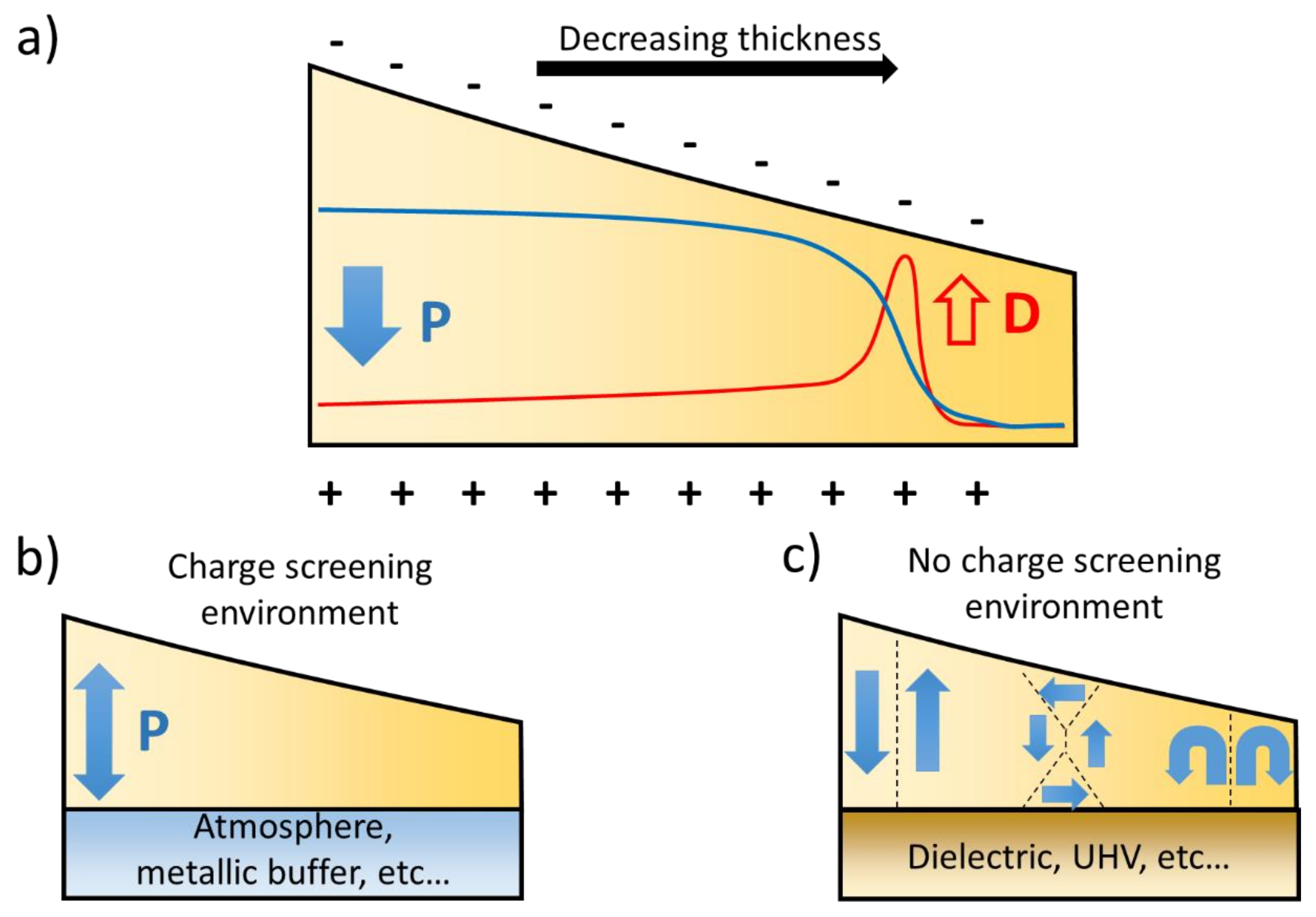
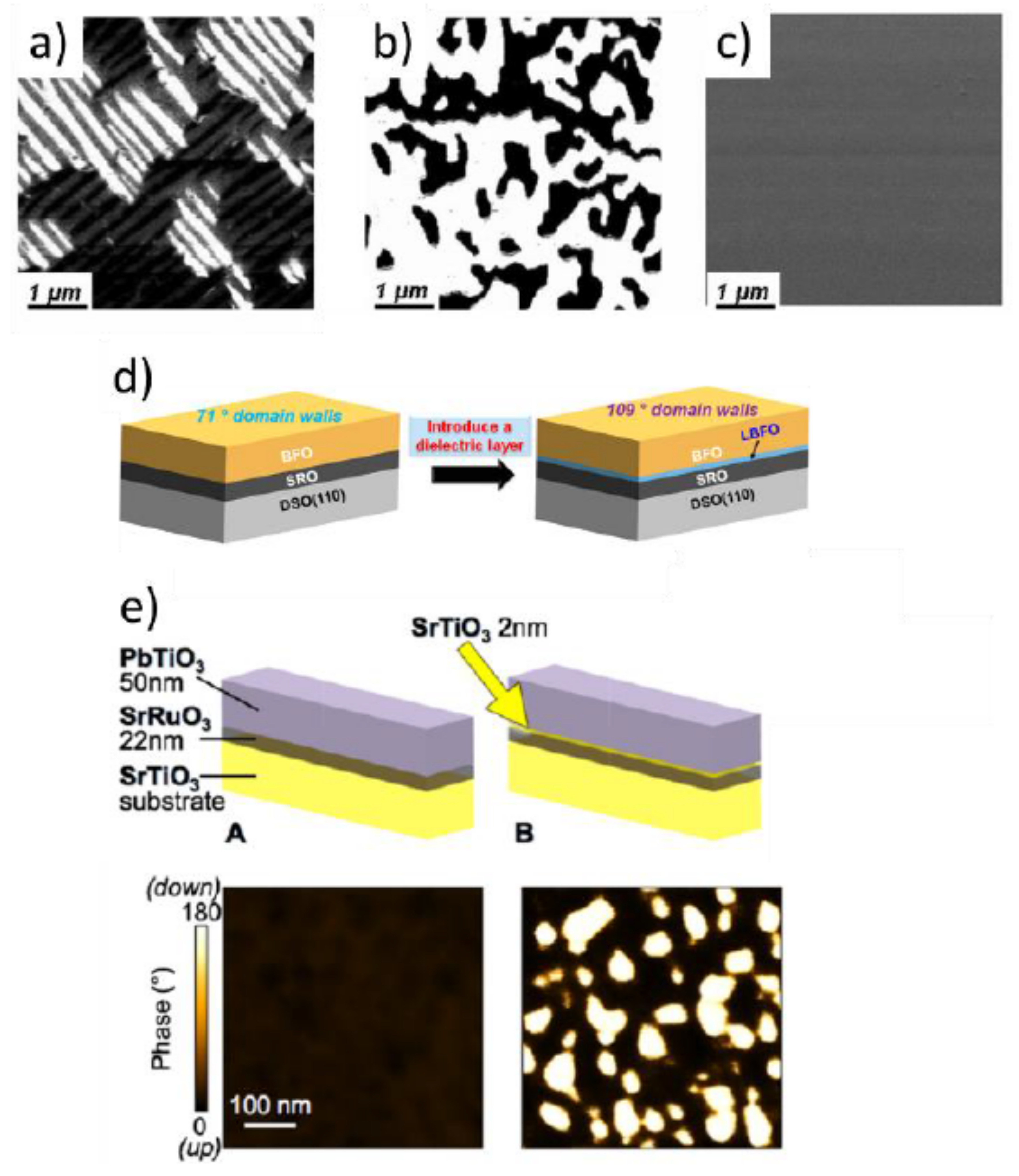
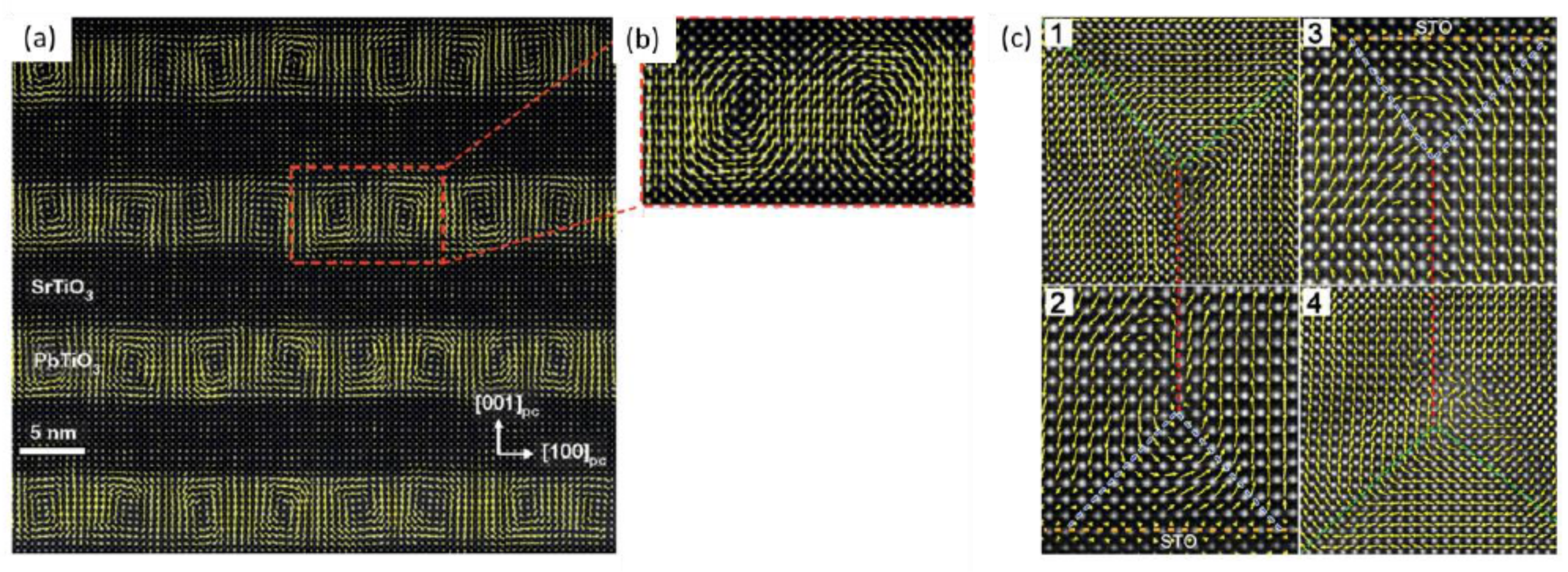

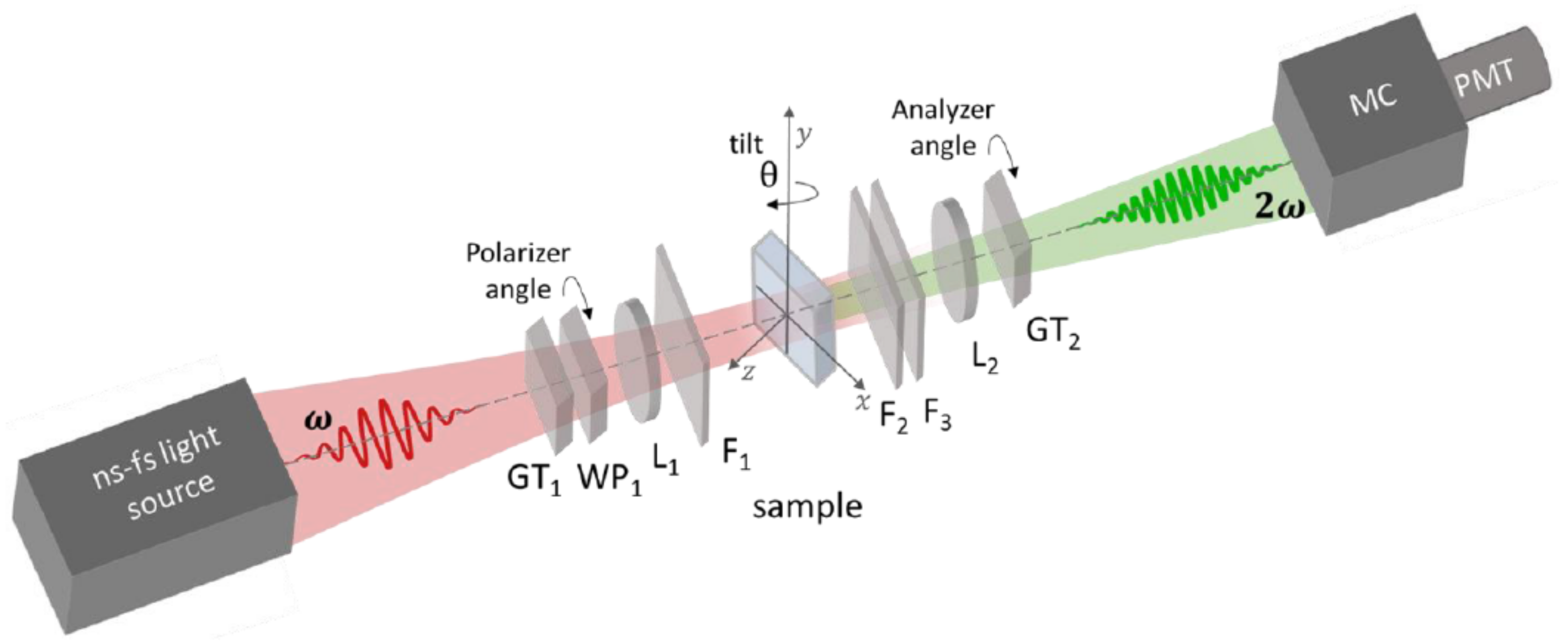

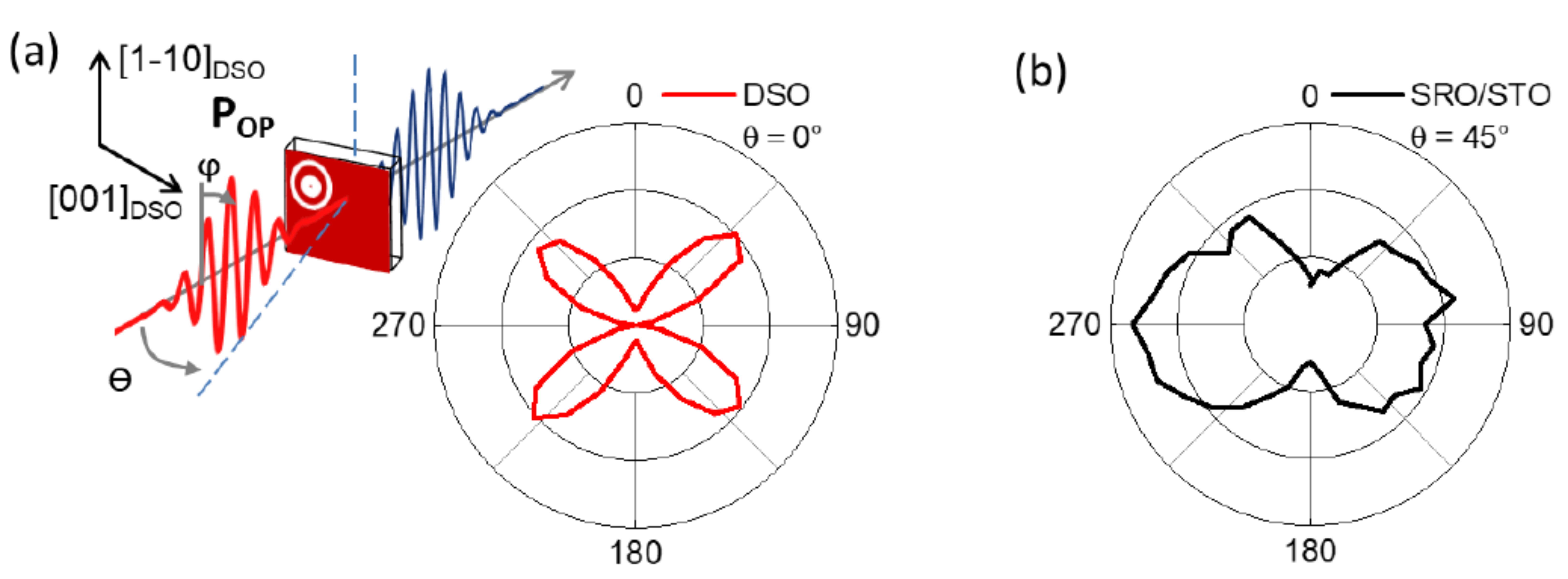

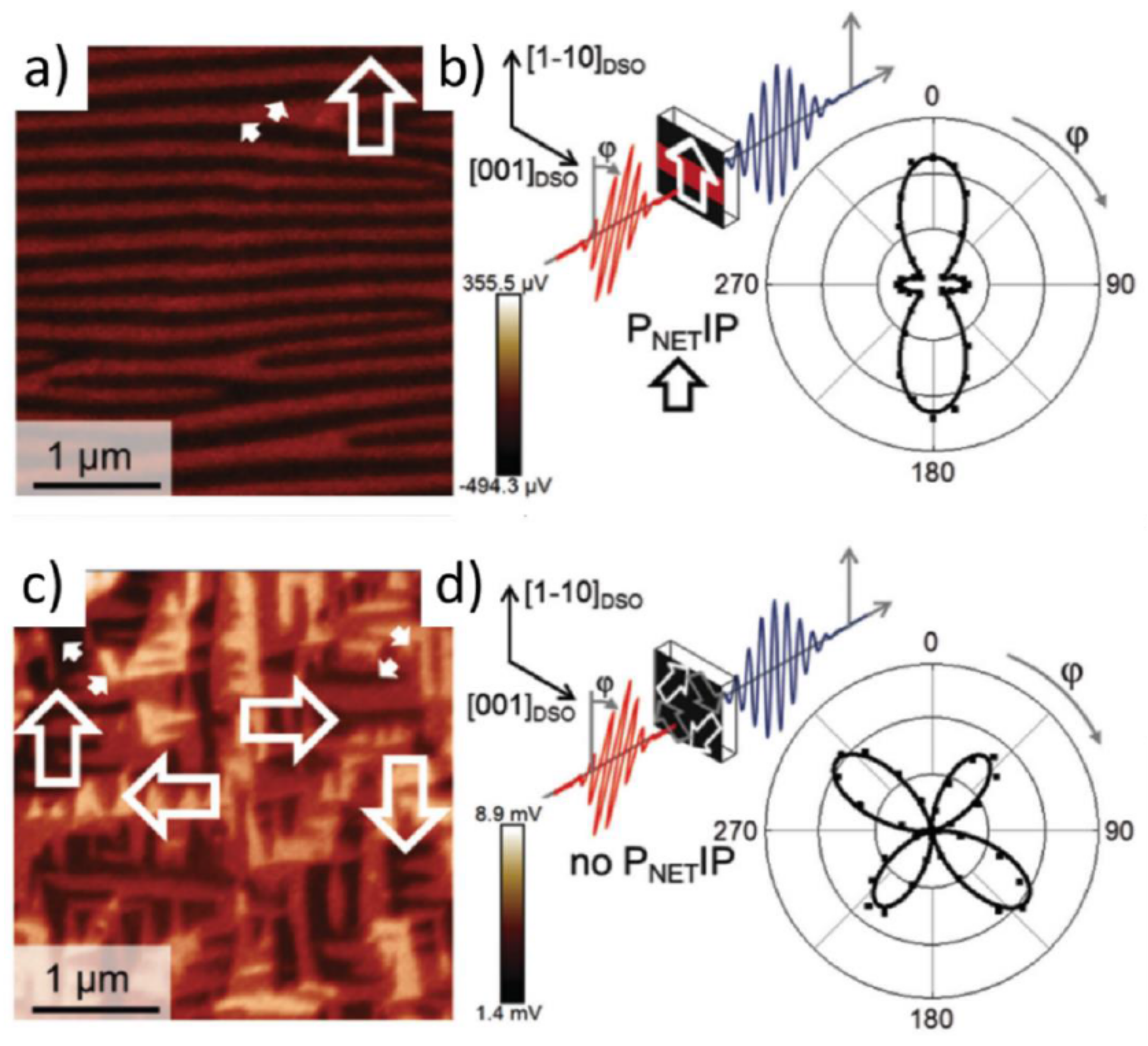
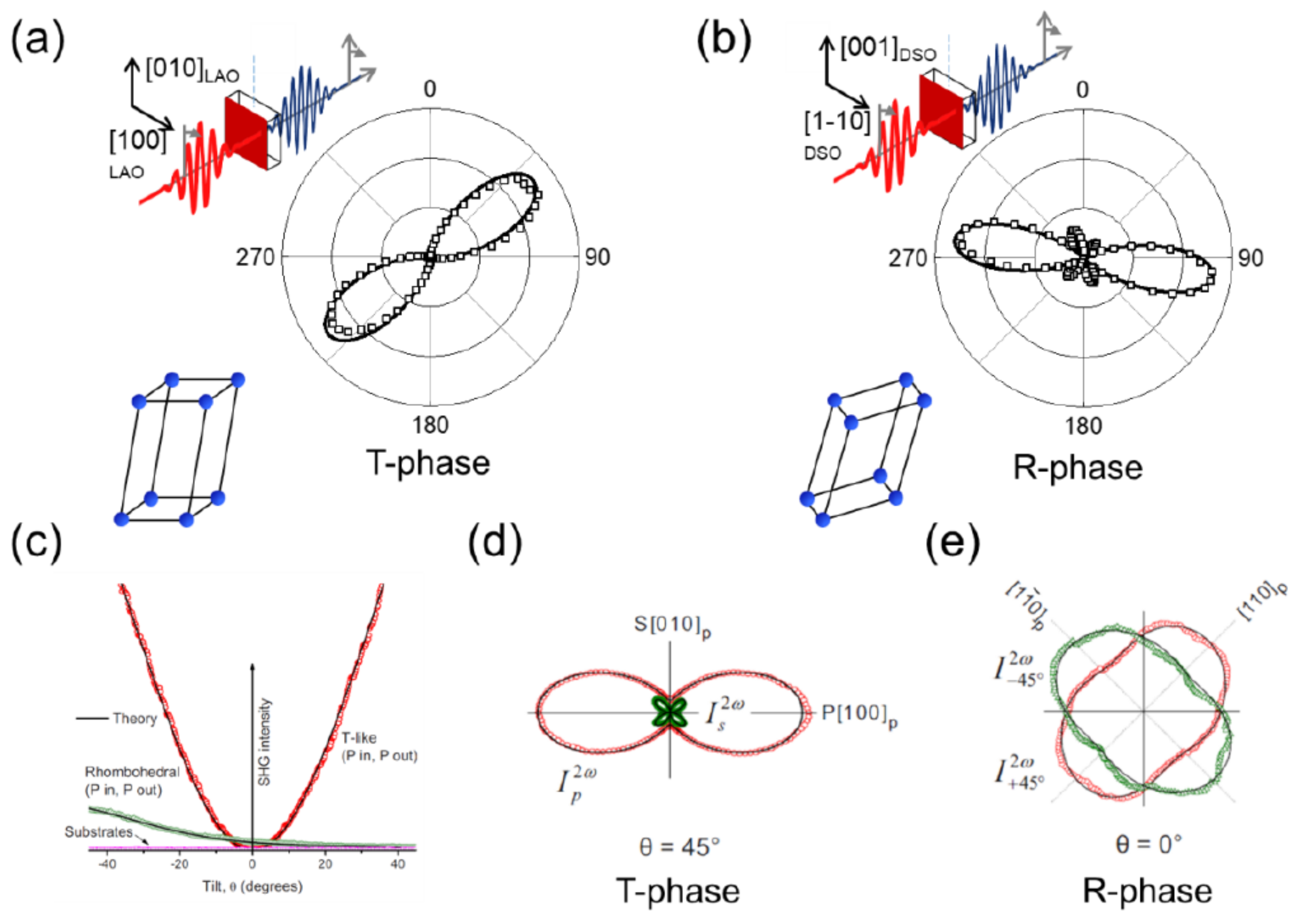

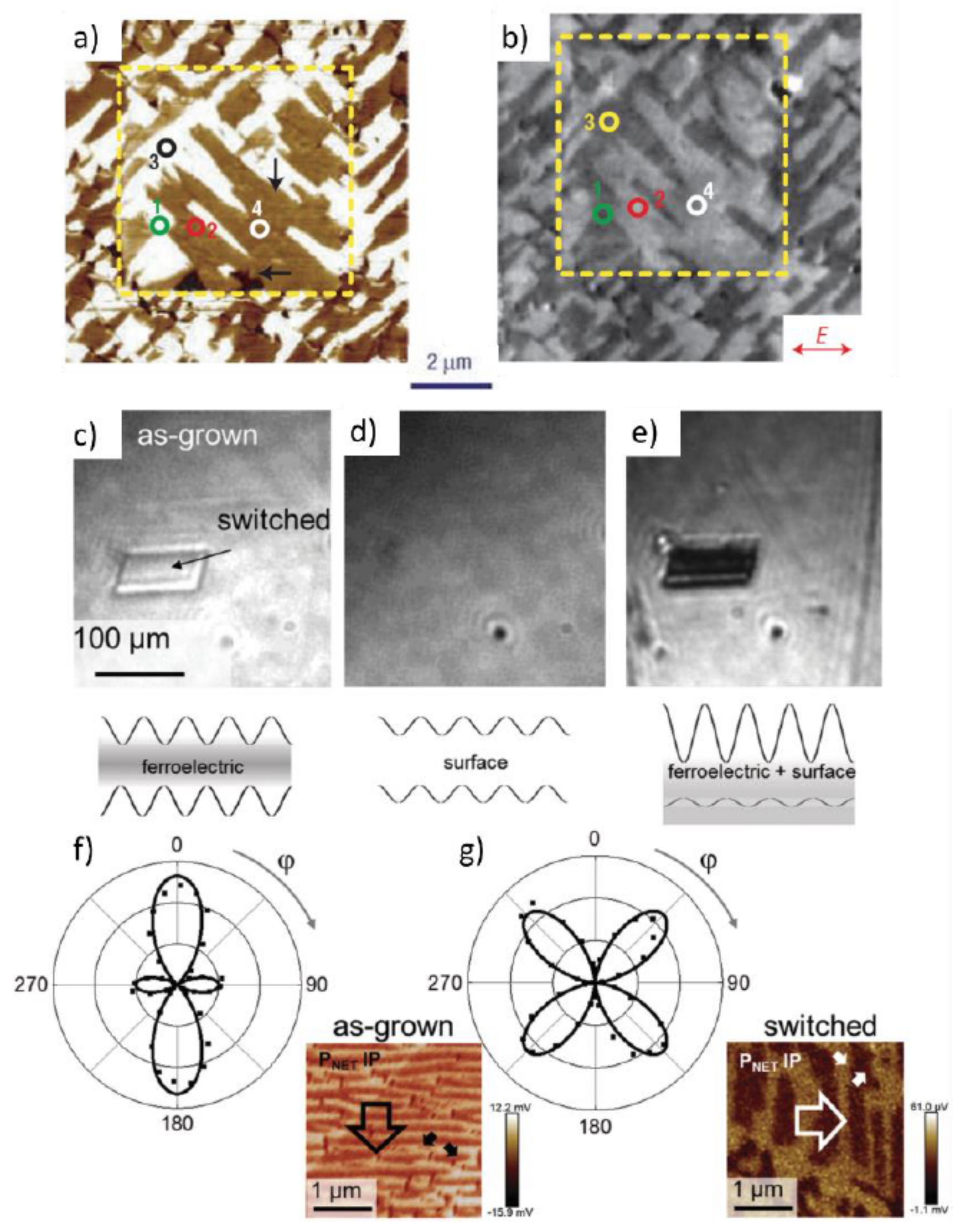
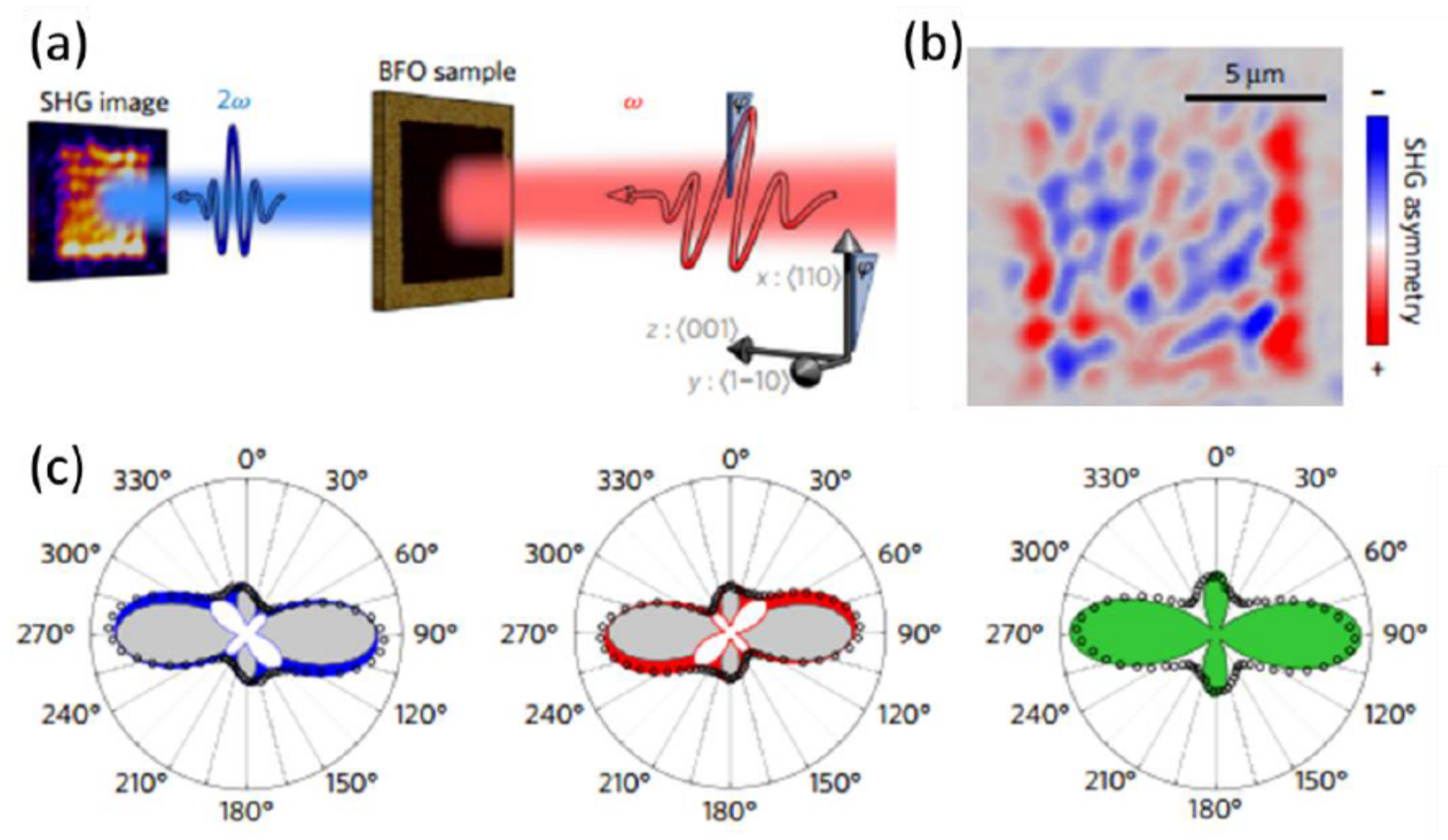
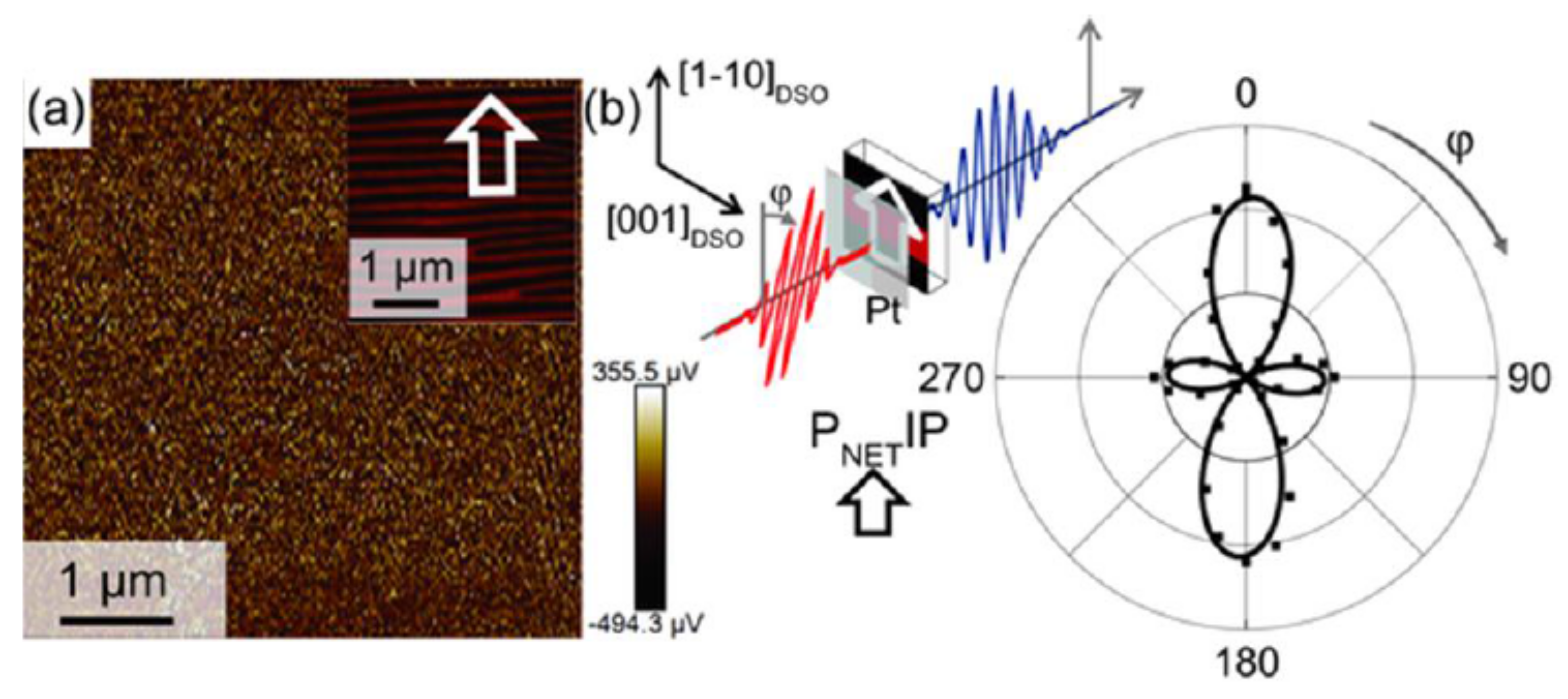
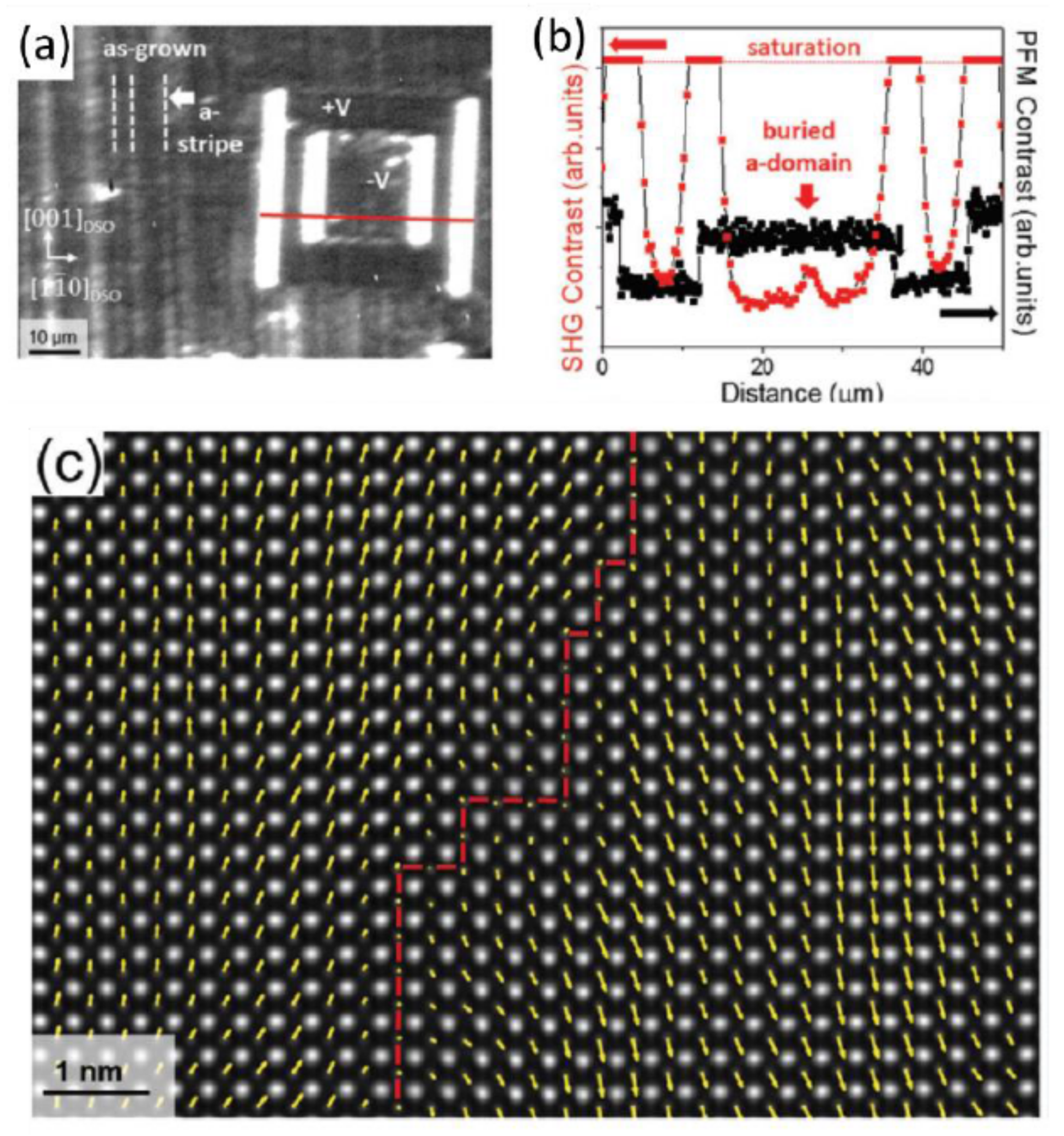
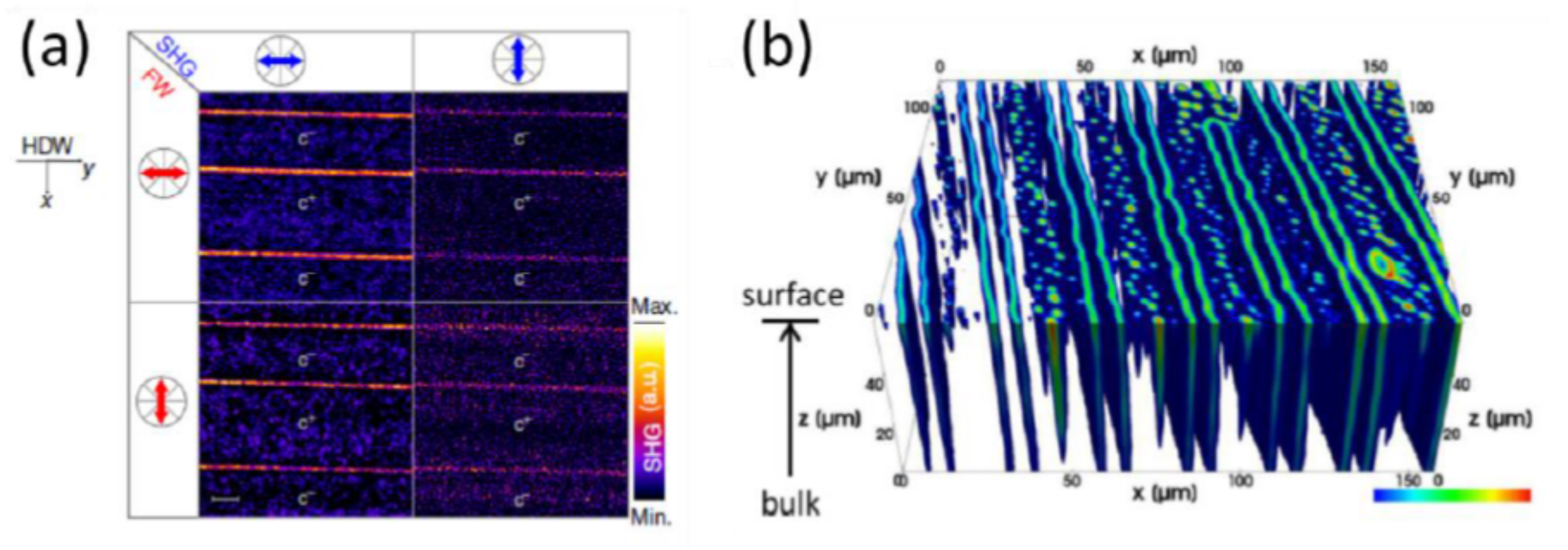
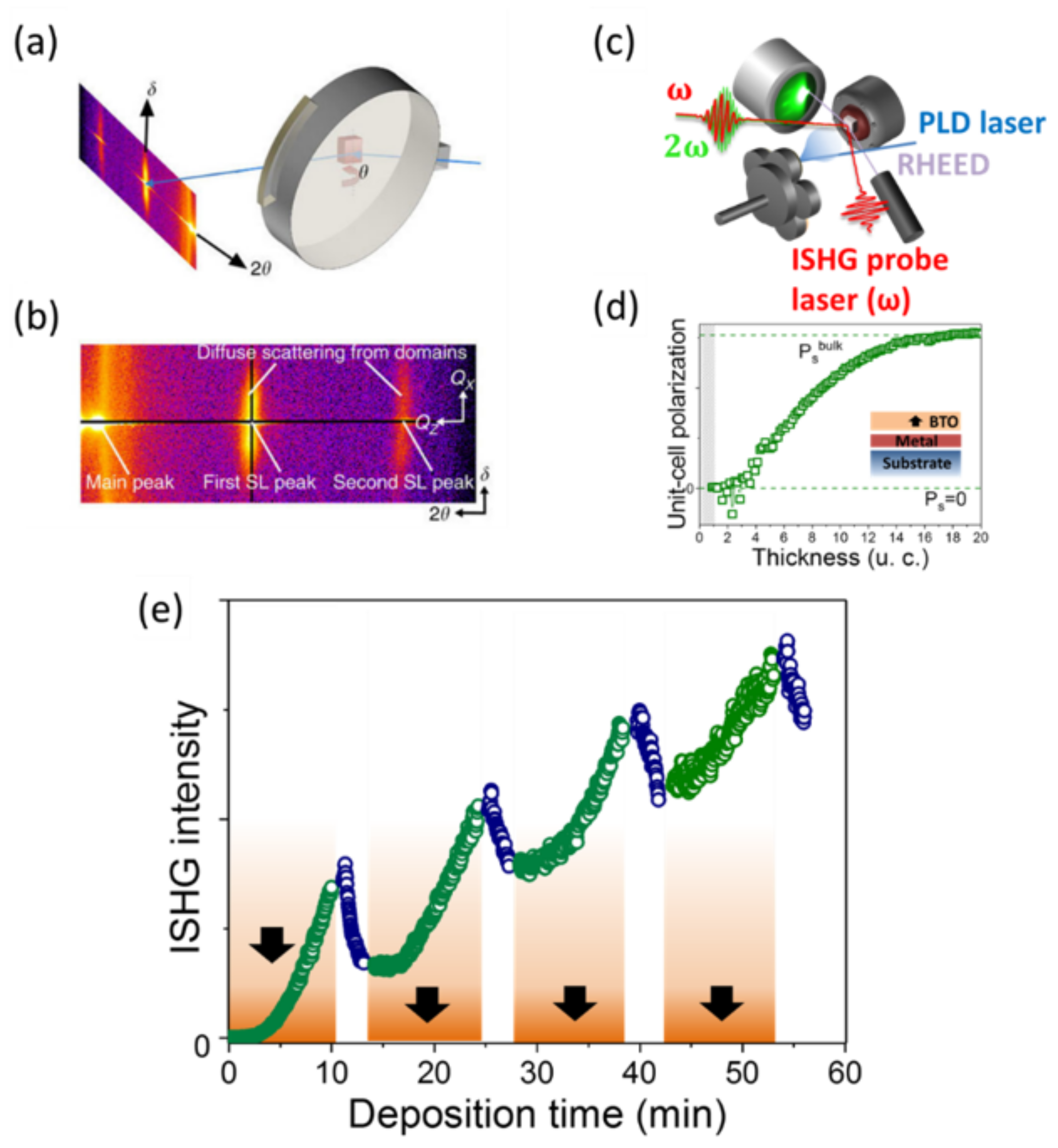
© 2018 by the authors. Licensee MDPI, Basel, Switzerland. This article is an open access article distributed under the terms and conditions of the Creative Commons Attribution (CC BY) license (http://creativecommons.org/licenses/by/4.0/).
Share and Cite
Nordlander, J.; De Luca, G.; Strkalj, N.; Fiebig, M.; Trassin, M. Probing Ferroic States in Oxide Thin Films Using Optical Second Harmonic Generation. Appl. Sci. 2018, 8, 570. https://doi.org/10.3390/app8040570
Nordlander J, De Luca G, Strkalj N, Fiebig M, Trassin M. Probing Ferroic States in Oxide Thin Films Using Optical Second Harmonic Generation. Applied Sciences. 2018; 8(4):570. https://doi.org/10.3390/app8040570
Chicago/Turabian StyleNordlander, Johanna, Gabriele De Luca, Nives Strkalj, Manfred Fiebig, and Morgan Trassin. 2018. "Probing Ferroic States in Oxide Thin Films Using Optical Second Harmonic Generation" Applied Sciences 8, no. 4: 570. https://doi.org/10.3390/app8040570
APA StyleNordlander, J., De Luca, G., Strkalj, N., Fiebig, M., & Trassin, M. (2018). Probing Ferroic States in Oxide Thin Films Using Optical Second Harmonic Generation. Applied Sciences, 8(4), 570. https://doi.org/10.3390/app8040570




